Annakisha
Houses within 5km of this house
Displaying 27 houses.
Houses within 5km of Annakisha
Displaying 27 houses.
| House name | Description | |
|---|---|---|
| Doneraile Court | A house of mainly early 18th century origin with 19th century additions located beside the village of Doneraile. Wilson, writing in 1786, describes it as "the magnificent and beautiful mansion, with extensive parks, gardens and demesnes". At the time of Griffith's Valuation the house was valued at £140. In 1942 the Irish Tourist Association Survey stated that the property had been bought by William St. Leger from Sir Walter Welmond and John Spenser, sonf of the poet Edmund Spenser. It was unoccupied in the 1940s and the agent was Mr. Hamilton. The house was sold to the Land Commission in 1969 by the wife of the 7th Viscount. The building was first restored by the Irish Georgian Society and since the early 1990s by various State bodies. It and the 400 acre demesne are now under the care of the Office of Public Works. |

|
| Kilburn/Kilbyrne | The White family resided at Kilburn from the early 18th century to the mid 20th century. The original building was replaced by a new house built in the late 1820s. This building was valued at £35 in the early 1850s. From 1903 to 1938 this house was the home of Colonel James Grove White who compiled the work ''Historical and Topographical Notes on Buttevant, Castletownroche, Doneraile and Mallow.'' The house was partly demolished in the mid 20th century. | |
| Carrig Park | This early 18th century house was the residence of William Causabon in 1744. By the 1770s it was the seat of a branch of the Franks family, who continued to reside there until the beginning of the 20th century. The house was held by William Hume Franks in fee at the time of Griffith's Valuation when the buildings were valued at £45 but the valuation was reduced to £35.10 shillings by 1906. The house was burnt in the early 1920s and later demolished. |

|
| Carrigoon | Occupied by Timothy Collins in the early 1850s and held from Joseph C. Nagle. The buildings were valued at £13. In 1942 the Irish Tourist Association survey noted its association with David Nagle who was MP for Mallow in 1689. The survey mentioned the survival at that time of the stables and coach house. A small ruined portion of this property remains, in an area where extensive quarrying has taken place. | |
| Mount Nagle | An early Nagle home which by the mid 18th century appears to have become the residence of the Linehan family. Hajba records a Mrs Linehan dying there in 1755 and at the time of Griffith's Valuation Myles Linehan occupied the house. He held it from Reverend William Nash and it was valued at £10. This house is still extant and occupied. | |
| Johnsgrove | Originally a Glover family home, by the time of Griffith's Valuation it was occupied by Francis F.P. Holmes and held from Walter Nugent. The buildings were valued at £30. This house is still occupied. |

|
| Castlekevin | Originally a Roche stronghold which was granted to William Thornhill a Cromwellian soldier. It remained the seat of the Thornhill family until the mid 19th century. The old castle was incorporated into a castellated mansion in the 1830s. Lewis writes in 1837 that the ‘present extensive castellated mansion was rebuilt by Mr Thornhill after designs by Mr Flood, in the Elizabethan style’. Sold by the Thornhills in the mid 19th century to the Reeves family in whose possession it remained until the 1930s. Still extant and occupied. |

|
| Killuragh | Built by the Thornhills in the late 18th century and soon afterwards leased to the Linehan family. Cornelius Linihan was resident in 1837 and Ellen Linehan in the early 1850s. She held the property from Edward B. Thornhill, the buildings were valued at £20. A lithograph of this house is included in the sale rental of 1851 but there is not much similarity between it and the present building which is now known as The Glen. |

|
| The Hermitage | Hajba states that this single storey house was built by the Reverend John Bagwell Creagh before 1814. Located on the Creagh estate it was occupied by J. Norcott in 1837 and by Samuel Morton Tuckey in the early 1850s, when the buildings were valued at £15.10 shillings. Later inhabitants included William Stawell. Home of the Broderick family in the 20th century. |
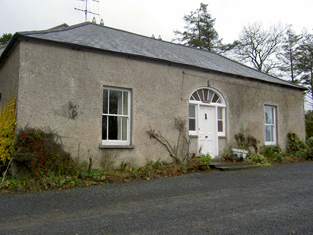
|
| Laurentinum | A mid 18th century house, seat of a junior branch of the Creagh family until the mid 19th century. Wilson refers to Laurentinum as the seat of Mr. Creagh in 1786. At the time of Griffith's Valuation occupied by Stephen Fagan who held it from the representatives of Michael Creagh. The buildings were valued at £32. Later sold to the MacCarthy Morroghs. Home of the Magner family in the 20th century. |
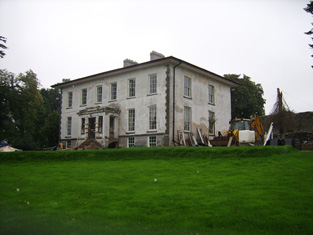
|
| Kilbrack | Hajba writes that this house was built by William Stawell who married Catherine Creagh of Creagh Castle. William was succeeded by his nephew the Reverend Francis Stawell in 1830. Kilbrack remained in Stawell possession until the end of the 19th century. It is still a family home. |

|
| Byblox | Burke's Landed Gentry of Ireland (1904) traces the Ross family of Dunmoyle from the Mann family of Byblox in the first half of the 18th century. Hajba writes that the original house was occupied by the Langley family in the 18th century. At the end of that century Roger Langley leased Byblox to Robert Fennel Crone who built a new house to replace the original which had been accidentally burnt. It was valued at £70 in the mid 19th century. The descendants of Robert F. Crone, including members of the Croker family, inhabited this six bay, three-storied house until the beginning of the 20th century when it was bought by the Morrogh Bernards. In the 1940s the Irish Tourist Association Survey noted that the house was then in the possession of Mrs. Drake Brockman but it was unoccupied with John Roche acting as agent. Byblox was demolished in the 1960s. |
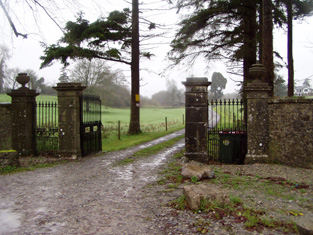
|
| Creagh Castle | Creagh Castle was acquired by Dr John Creagh in the late 18th century and passed to his daughter Mary and her husband, Kilner Brooke Brasier. Their second son, John Brasier-Creagh, inherited Creagh Castle and is credited with building the present house, the original one having been destroyed by a fire. George Washing Brasier Creagh held Castle Creagh in fee at the time of Griffith's Valuation. The buildings were valued at £50. The descendants of John's brother, George Washington Brasier Creagh, continued to live at Creagh Castle until the 1930s. In 1906 the building was valued at £44+ and occupied by Captain John Brazier Creagh. In the 1940s the Irish Tourist Association Survey noted that there was a castle formerly associated with the Coppinger family on this property. |

|
| Crobeg | Home of a branch of the Stawell family throughout the 19th century. The family were involved in the flour milling business at Doneraile. At the time of Griffith's Valuation George Stawell held Crobeg from the representatives of Luke Hassard. The buildings were valued at £36. The house was demolished in the 1980s. |

|
| Cromore | John Creagh leased part of Castlesaffron to Luke Hassard in the late 18th century, who Hajba writes built the house Cromore. Soon afterwards it became the home of the Campion family and Roland Campion was resident at the time of Griffith's Valuation, holding the property from the representives of Luke Hassard. The buildings were valued at £15. Later the home of the Graham family. The building was extensively rebuilt and restored in the 1980s. | |
| Saffron Hill Cottage | Hajba writes that this house was built in the first decade of the 18th century by Reverend Edward Sayers, rector of Templeroan. An Edmund Sayers is recorded as the occupant in the early 1850s. He held the property from Viscount Doneraile. The buildings were valued at £22. The Sayers estate at Croghnacree was advertised for sale in November 1859, November 1864 and May 1865. In 1906 Lord Castletown was recorded as the occupier. This house, an eleven bay single storey building, ceased to be a residence in the mid 20th century but has since been restored and is now inhabited again. Reference to the Sayers family in the Moore sale rental of 27 Feb 1863. This house is also associated with the Brasier Creagh family. |

|
| Ballygriffin | Described by Smith in the mid 18th century as "a pretty seat of Mr David Nagle". This house was the birthplace of Nano Nagle. By 1814 Ballygriffin was occupied by William J. Boyce and in the early 1850s by Ellen Linehan who held the property from J.C. Nagle. The buildings were valued at £6. In 1942 the Irish Tourist Association Survey reported that the building was in ruins but it was restored in the late 20th century and is now known as the Nano Nagle Centre, preserving the heritage of the Presentation Nuns worldwide. |
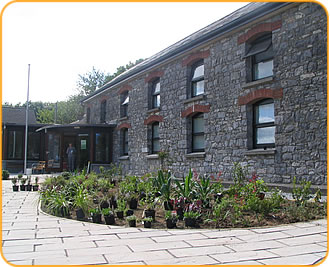
|
| Ballyviniter | A Stawell residence in the 18th and 19th centuries, occupied by George C. Stawell in the early 1850s, when the buildings were valued at £15. Stawell held the property in fee. The original house is not extant. | |
| Rough Hill | The home of the Harmon family from the late 18th to the late 19th century. At the time of Griffith's Valuation Samuel Harman occupied the house valued at £12 and held from Sampson French. Buildings are still extant at the site. | |
| Carrigacunna Castle | This house was the residence of Henry Baldwin Foote in the 19th century. Lewis writes that the estates of Monanimy, Ballygriffin & Carrigacunna formerly belonged to the ancient family of Nagle and that Carrigacunna was the residence of Sir Richard Nagle, Private Secretary to James II, who forfeited the estate in the late 17th century. In 1837 it was the property of H. B. Foott. He was the occupier in the early 1850s, the buildings were valued at £34 and the property was held in fee. Hajba writes that Henry's son George Carleton Foott lived at Carrigacunna until 1929. The Humphreys family were living here in the mid 20th century. The Irish Tourist Association Survey noted in the 1940s that Major Humphreys was residing in "a handsome modern mansions, adjoining the ruins of the old castle". The house was restored in the late 20th century. |

|
| Ballymagooly | The home of the Franks family in the mid 18th century. John Nash was living here in the late 18th century. In 1790 his daughter Catherine married Robert Courtenay of Ballyedmond and the property passed to the Courtneys. Ballymagooly was occupied by the Courtneys in 1814 and in 1837. Held by John Courtney in fee at the time of Griffith's Valuation when the buildings were valued at £35. Also known as The Garrison the house was burnt and the stableblock converted into a residence in 1955. |

|
| Carrigoon House | A Stawell home in 1750 and the home of Michael Nash in the latter part of the 18th century. Occupied by James Curtin in 1814 and by William H. Franks at the time of Griffith's Valuation. It was held by Franks in fee and valued at £15. A few ruins remain of this house. | |
| Rockforest Lodge | This house was the residence of Pierse Creagh in 1837. At the time of Griffith's Valuation Henry O. Seavers occupied this house, valued at £24 and held by him in fee. This house is still inhabited. In 2010 it was offered for sale. see http://www.michaelhdaniels.com/index.cfm?fuseaction=propsearch |

|
| Rockforest | The seat of the Cotter family from the mid 18th century and occupied by them until the 20th century. Wilson, writing in 1786, describes it as "a most beautiful improvment, highly wooded, situated on the Blackwater, the seat of James Laurence Cotter". Occupied by Mrs J.R. Cotter, sister-in-law of the 3rd Baronet, in the mid 19th century when the buildings were valued at £18. By 1906 its value had risen to £38.15 shillings. Only half of the house now survives, the Irish Tourist Association Survey of 1942 noting that "the greater part of the building had been knocked down". For sale in 2012 through Savills. |
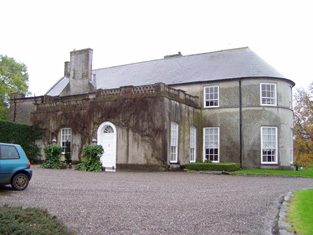
|
| Ballymacmoy | The Hennessys were settled at Ballymacmoy from the mid 18th century. In 1786 Wilson refers to "Ballymacboy" as the seat of Mr. Hennessy. A new house was built circa 1820s. By the time of Griffith's Valuation the Hennessy home was valued at £13.5 shillings and was held in fee by James Hennessy. He also owned a flour mill valued at £70 which he leased to Henry B. Foote. This house was still a Hennessy home in the 20th century and the house is still extant. |
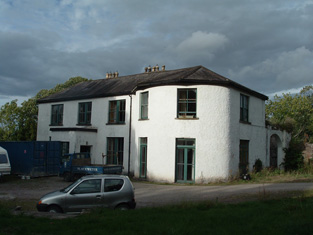
|
| Monanimy Castle | In the mid 19th century William Barry occupied Monanimy Castle which was valued at £15.10 shilllings and held from George Bennett. Hajba writes that Barry restored the castle and that he was related to the Nagles who had originally owned the castle. The Barrys remained as residents of the castle until the 1940s when the castle was damaged by a fire. It has been restored and is now a family home. | |
| Dromrahan | A mansion house valued at £20 is recorded at Dromrahan in 1906. Matthew H. Franks was the occupier. This house was built in the second half of the 19th century and is not recorded in Griffith's Valuation. A large complex of buildings at the site is labelled Dromrahan House on the 25-inch Ordnance Survey map of the 1890s. It is still extant and occupied. |
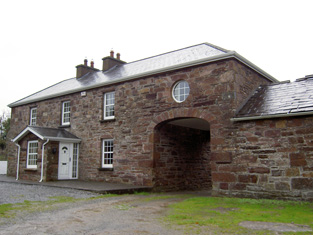
|

